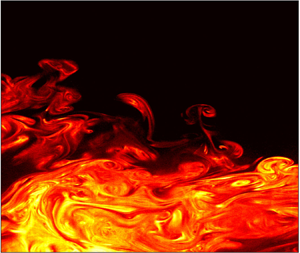Article contents
On the physical nature of the turbulent/turbulent interface
Published online by Cambridge University Press: 23 May 2022
Abstract

The existence of a turbulent/turbulent interface (TTI) has recently been verified in the far wake of a circular cylinder exposed to free-stream turbulence (Kankanwadi & Buxton, J. Fluid Mech., vol. 905, 2020, p. A35). This study aims to understand the physics within the TTI. The wake boundary, approximately 40 diameters downstream of a circular cylinder subjected to grid-generated turbulence, was investigated through simultaneous cinematographic, stereoscopic particle image velocimetry and planar laser induced fluorescence experiments. With no grid placed upstream of the cylinder, the behaviour of the resultant interface, our closest approximation to a turbulent/non-turbulent interface, exactly matched what is observed in existing literature. When background turbulence is present, viscous action is no longer the only method by which enstrophy is transported to the background fluid, unlike for turbulent/non-turbulent interfaces. The presence of rotational fluid on both sides of the TTI allows the vorticity stretching term of the enstrophy budget equation to be the dominant actor in this process. The role of viscosity within a TTI is greatly diminished as the vorticity stretching term takes over responsibilities for enstrophy production. The turbulent strain rate normal to the TTI was found to be enhanced in the interfacial region. Decomposing the vorticity stretching term into components aligned with the three principal strain-rate directions, it was found that the term most aligned with the interface-normal direction contributed to the largest share of enstrophy production. This indicates that better ‘organised’ vorticity on the wake side of the interface yields the enstrophy amplification leading to the previously discovered enstrophy jump across the TTI by Kankanwadi & Buxton (J. Fluid Mech., vol. 905, 2020, p. A35).
JFM classification
- Type
- JFM Papers
- Information
- Copyright
- © The Author(s), 2022. Published by Cambridge University Press
References
REFERENCES
- 9
- Cited by





